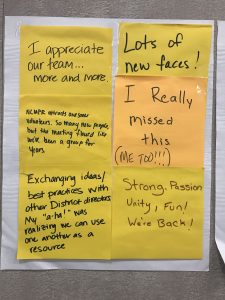by Jaclyn Y. Garver
NCMPR Administrative Services Coordinator
Fort Wayne, IN
 Last month, NCMPR’s staff and board members gathered in Denver for our annual summer board meeting and a few days of strategic planning. Due to some new volunteers and hires, it was the first time many of us had been together, in-person, all at once, ever — including the six staff members.
Last month, NCMPR’s staff and board members gathered in Denver for our annual summer board meeting and a few days of strategic planning. Due to some new volunteers and hires, it was the first time many of us had been together, in-person, all at once, ever — including the six staff members.
At various points over the last year and a half, I wondered what in-person time would look like when we could again gather. Would I forget how to compose a sentence that wasn’t first typed up? Would I stand too far, the crumbs of social distancing still lingering on my conscience, so that we’d have to shout at one another? Would I get so excited to see another human that I’d fling myself at them for a hug when all they were looking for was a fist bump or handshake?

I wasn’t the only one thrilled to be meeting again in person. During a strategic planning session, a number of others shared an appreciation for one another.
I’m happy to report that the year-plus of isolation didn’t turn me into a social pariah (at least, I don’t think it did — you might have to check with my coworkers to be extra certain). But for a lot of us, those questions still linger, especially as they relate to our colleges. How are students feeling about coming back on campus? What aspects of virtual learning did they prefer, if any? How can we engage students in person again while still being mindful of the fact that the coronavirus pandemic isn’t actually over?
Carnegie Dartlet, a Massachusetts-based higher ed marketing and research group, surveyed more than 1,500 people looking to start college in fall 2022 and beyond. You can find the full results online, but these are some of the findings that you might find most helpful or interesting.
Campus Visits: Yes, Please!
More than half (55%) of prospective students surveyed said a campus visit is highly important or critical, which is level with the pre-pandemic statistic. Students who rated on-campus visits as more important were more likely to be white and/or from the Midwest or South.
Before you go throwing away whatever virtual tours you’ve put together since March 2020, though, it’s worth noting that this still leaves 45% who might be pretty thrilled to tour your campus online. That’s one aspect of virtual work that could have good, lingering effects: Those who want a campus visit will get a campus visit. But a good chunk — the introverts, those still worried about the pandemic, those unable to tour due to a disability, for example — will be grateful for your virtual options.
Interest in Virtual Learning Is Up … a Little
Before the pandemic, interest in online courses ranked 2.16 out of 5. Today, it’s at 2.34.
“The many peaks and valleys of interest indicate that online coursework is seen similarly to before the pandemic and will shift due to individual factors and other large-scale cultural events,” according to the report.
This is not to say to get rid of virtual courses, which can lead to degrees for those who wouldn’t otherwise be able to complete coursework, from single parents to those with disabilities.
Will Students Be Vaxxed?
Students who’ve planned to be vaccinated or who’ve already been vaccinated: 63%
Students who are undecided about getting vaxxed: 22%
Students who have zero intention of getting vaxxed: 13%
Those numbers do vary by region and demographic:
- Percent of Asian students most likely not to be/get vaxxed: 30
- Percent of white students most likely not to be/get vaxxed: 17
- Percent of Black students most likely not to be/get vaxxed: 16
Students in the Northeast were most likely to be/get vaccinated, especially when compared to students in the South.
Who Can Help? Counselors and Current Students
It’s no surprise that prospective students aren’t exactly interested in hearing from marketers (and really, who is? I love us … but we know this). Instead, they’d like to hear from current students and counselors.
That makes this the perfect time to craft a marketing campaign from one or two stand-out students. Write in their voice; get some candid shots of them on- and off-campus; send a pen pal-esque postcard. Then, stick with the campaign. As the report points out, “consistent messaging will keep students from second-guessing source credibility. Training not only on facts but a consistent personality frame will make for a more compelling and memorable experience.”
Stick with Email … and Snail Mail
If you’re going to reach out to prospective students, they’re most comfortably receiving your messaging via email or postal mail. Next is a text, then a social media DM or online advertising. Last up: a phone call. (No surprise there. I’ll never forget working with an intern who was bright, creative, a hard worker, the sort who makes you teary when he graduates … and, I swear, I think he’d rather have a cavity filled than pick up the phone for a 10-second phone call to verify something with a program chair.)
Knowing how meh prospects are about hearing from you on social media might be helpful in deciding where to spend your social media energy. Is it vital to maintain three and four different platforms? Probably not. Better to focus on making one or two great than spreading yourself thin.
Oh, and the trend continues: Younger audiences are less likely to use professional social media (LinkedIn). (Is anyone surprised here?)
So what are the chances of completion?
Of the students surveyed, more than half (51%) said they’d not delay college for any reason. A full 93% are confident they’ll graduate on time.
Those most likely to delay? (You know where this is going … ) Those who plan on their two-year degree.
Ugh.
Jaclyn Y. Garver is the communications specialist at NCMPR and the former communications coordinator at Ivy Tech Community College in Fort Wayne, Indiana.


STAY CONNECTED